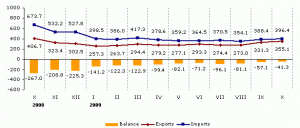TALLINN — While economists have their eyes peeled on the Baltic states for the latest sign of either recovery or further decline, two trends have emerged.
Latvia’s foreign trade has increased for the second month in a row, while Estonia’s continues to stagnate. Meanwhile the trade deficits that were hallmarks of the “Baltic Tiger” boom is close to being eliminated as both countries’ are nearing a surplus for the first time in years, according to numbers released this week by the department of statistics of each country.

Latvian foreign trade, in millions of lats, from Oct. 2008-Oct. 2009. Source: Latvian Central Statistical Bureau
The amount of imports and exports are continuing to increase in conjunction with one another, but the gap between them has steadily decreased in Latvia, which had twice the current account deficit of Estonia in 2008 and the widest in the European Union, since last October. Estonia’s trade deficit has fluctuated more but is on the decrease since July.
Even during the peak of the boom, economists long pointed to the Baltic states’ current account deficits as weaknesses that would make them vulnerable to an economic downturn and cutoff of Scandinavian credit. Now the drop in domestic demand caused by the real estate bubble’s burst, increasing unemployment, lower wages and declining business activity is correcting this vulnerability, albeit with harsh side effects.
“The drastic downturn in domestic demand has already eliminated two key imbalances in the Baltics — extremely large current account deficits and high wage-driven inflation. Future external balances will be close to equilibrium or even slightly positive, like this year. Price pressure will remain weak,” a recent SEB “Nordic Outlook” macroeconomic report reads. “The fundamental problem in the Baltic economies was excessive domestic demand, not obvious weaknesses in exports.”
The cutoff of easy credit from the West forcefully corrected any excess domestic demand. But it’s unclear whether a recovery, still considered at least half a year if not more than a year away, could bring back those vulnerabilities or not, considering the small size of Latvia’s and Estonia’s economies. The governments are taking measures to ensure that doesn’t happen, though.
“The focus of fiscal measures is not only on short-term economic stabilization. Latvia is also slimming its bureaucracy. New capital gains and housing taxes are also being planned to prevent new overheating in the future … Estonia’s reforms include steps to strengthen its unemployment insurance system and increase the flexibility of its labor market,” the report reads.













